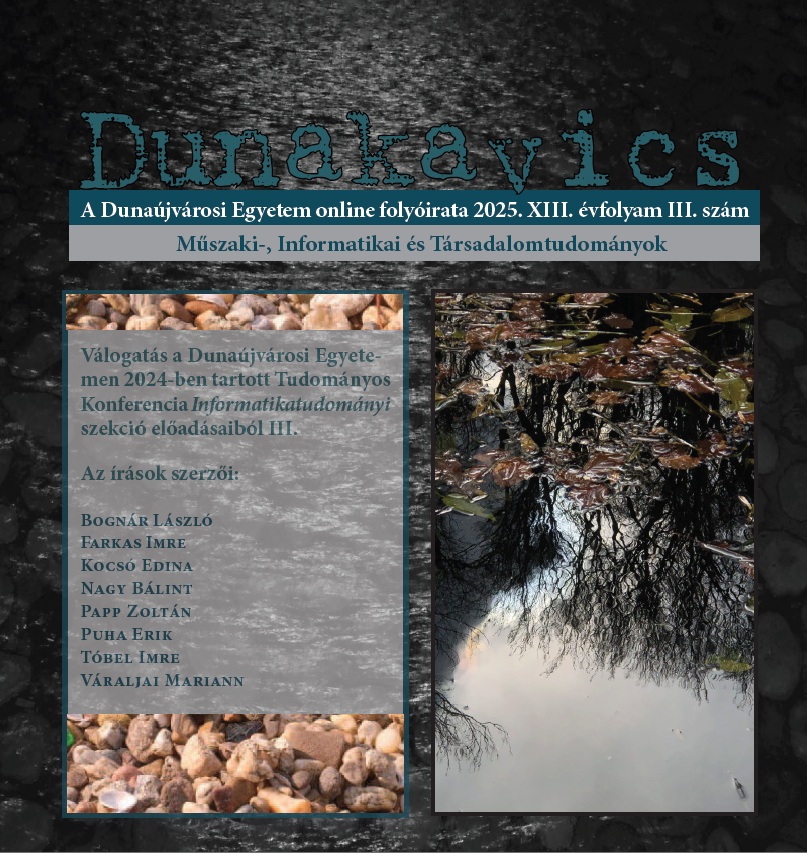Matematikai modellektől a tanuláselemzésig
Absztrakt
A matematikai modellezés alapvető módszertani eszköz, amelyet a természeti és társadalmi jelenségek mélyreható megértésére és elemzésére alkalmazunk. Az összetett rendszerek egyszerűsítése révén a matematikai modellezés lehetőséget nyújt arra, hogy a különféle változók közötti kapcsolatokat felfedezzük és a rendszer viselkedését előre jelezzük, így különösen hasznos olyan meglepőnek tűnő területeken, mint a tanuláselemzés.
Hivatkozások
Vallis, G. K. (1988): Conceptual models of El Niño and the southern oscillation. Journal of Geophysical Research: Oceans, 93., (11.), pp. 13979-13991. https://doi.org/10.1029/JC093iC11p13979
Bouali, S.-Buscarino, A.-Fortuna, L.-Frasca, M.-Gambuzza, L. V. (2012): Emulating complex business cycles by using an electronic analogue. Nonlinear Analysis: Real World Applications, 13., (6.), pp. 2459-2465. https://doi.org/10.1016/j.nonrwa.2012.02.010
Joós, A. (2022): On packing of unequal squares in a rectangle. Acta Polytechnica Hungarica, 19., (1.). https://doi.org/10.12700/APH.19.1.2022.19.4
Olde Scheper, T.-Klinkenberg, D.-Pennartz, C.-Van Pelt, J. (1999): A mathematical model for the intracellular circadian rhythm generator. Journal of Neuroscience, 19., (1.), pp. 40-47. https://doi.org/10.1523/JNEUROSCI.19-01-00040.1999
Demšar, I.-Bernik, R.-Duhovnik, J. (2012): A mathematical model and numerical simulation of the static stability of a tractor. Agriculturae Conspectus Scientificus, 77., (3.), pp. 143-150.
Beran, B.-Kargi, F. (2005): A dynamic mathematical model for wastewater stabilization ponds. Ecological modelling, 181., (1.), pp. 39-57. https://doi.org/10.1016/j.ecolmodel.2004.06.022
Brodie, M. A.-Walmsley, A.-Page, W. (2008): Dynamic accuracy of inertial measurement units during simple pendulum motion. Computer methods in biomechanics and biomedical engineering, 11., (3.), pp. 235-242. https://doi.org/10.1080/10255840802125526
Newman, K. B.-Buckland, S. T.-Morgan, B. J.-King, R.-Borchers, D. L.-Cole, D. J.-Thomas, L. (2014): Modelling population dynamics. Modelling Population Dynamics: Model Formulation, Fitting and Assessment using State-Space Methods. New York: Springer, pp. 169-195. https://doi.org/10.1007/978-1-4939-0977-3_9
Xepapadeas, A. (2005): Economic growth and the environment. Handbook of environmental economics, 3., pp. 1219-1271. https://doi.org/10.1016/S1574-0099(05)03023-8
Srivastava, R.-You, L.-Summers, J.-Yin, J. (2002): Stochastic vs. deterministic modeling of intracellular viral kinetics. Journal of theoretical biology, 218., (3.), pp. 309-321. https://doi.org/10.1006/jtbi.2002.3078
Gonze, D.-Halloy, J.-Goldbeter, A. (2002): Deterministic versus stochastic models for circadian rhythms. Journal of biological physics, 28., pp. 637-653. https://doi.org/10.1023/A:1021286607354
Beckmann, M. (1952): A continuous mo-del of transportation. Econometrica. Journal of the Econometric Society, pp. 643-660. https://doi.org/10.2307/1907646
Shieh, L. S.-Wang, H.-Yates, R. E. (1980): Discrete-continuous model conversion. Applied Mathematical Modelling, 4., (6.), pp. 449-455. https://doi.org/10.1016/0307-904X(80)90177-8
Dæhlen, A.-Heldal, I.-Rehman, A.-Ali, Q.-Katona, J.-Kővári, A.-Costescu, C. (2024, June): Towards More Accurate Help: Informing Teachers how to Support NDD Children by Serious Games and Eye Tracking Technologies. In: Proceedings of the 2024 Symposium on Eye Tracking Research and Applications. pp. 1-7. https://doi.org/10.1145/3649902.3653943
Katonáné Gyönyörű, K. I. (2024): The Role of AI-based Adaptive Learning Systems in Digital Education. Journal of Applied Technical and Educational Sciences, 14., (2.), pp. 1-12.




